Chris is a gardening writer and nature enthusiast. He graduated from Oxford Brookes University in 2022 with an MA in Psychology. Chris works with the Leeds Green Action Society, helping their food cooperative by growing various fruit and vegetables on their two allotments in Hyde Park, Leeds.
Reviewed By COLIN SKELLY

Colin is a Horticulturist and Horticultural Consultant with experience in a range of practical and managerial roles across heritage, commercial and public horticulture. He holds the Royal Horticultural Society’s Master of Horticulture award and has a particular interest in horticultural ecology and naturalistic planting for habitat and climate resilience.
Contributions From NAOMI SLADE

Naomi Slade is a Gardener, Author and Consultant with 25 years’ experience in writing. Naomi has published several books, presented on mainstream TV shows and written for various gardening publications. In 2022 she won the Garden Media Guild’s Best Practical Journalist Of The Year award.
You may be wondering, “why are there no birds in my garden?”
Fret not, even if there are none visiting at the moment, there are ways to lure them in.
The first step in most cases is to provide them with something to eat.

And don’t worry, you’re not stuck if you live in a city – this guide will tell you how to attract birds to an urban garden, too.
This guide focuses on three main things: food, water, and shelter.
And here’s what you might need:
- A bird feeder.
- A bird bath.
- A nest box.
- Bushes or shrubs with berries.
- Plants that attract insects.
Let’s get started.
Identifying Visiting Birds
First up, here are some tips and resources for identifying the birds that come to visit.
If you aren’t a keen ornithologist, the Royal Society for the Protection of Birds (RSPB) have a great bird identification tool.1Bird Identifier. (n.d.). The RSPB. Retrieved March 17, 2023, from https://www.rspb.org.uk/birds-and-wildlife/wildlife-guides/identify-a-bird/
Just plug in the particulars of a bird, and the tool will tell you what you’re looking at.
There are also tons of bird-spotting books available online, at libraries, and often at charity shops.
According to the RSPB, here are the most common garden birds that you’re likely to see:
Starlings
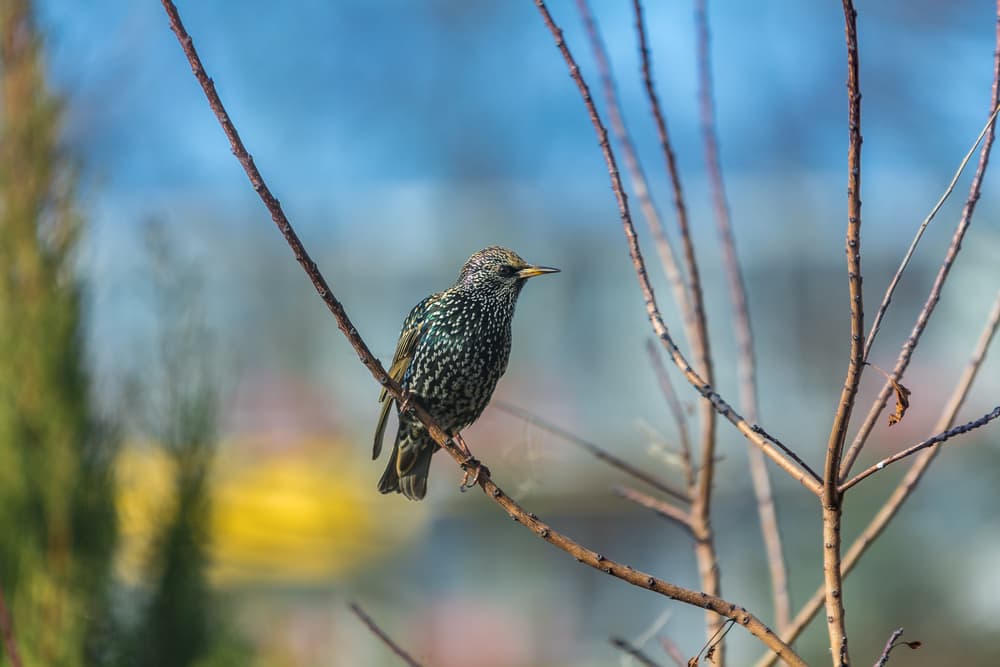
House Sparrows

Blackbirds

Blue & Great Tits
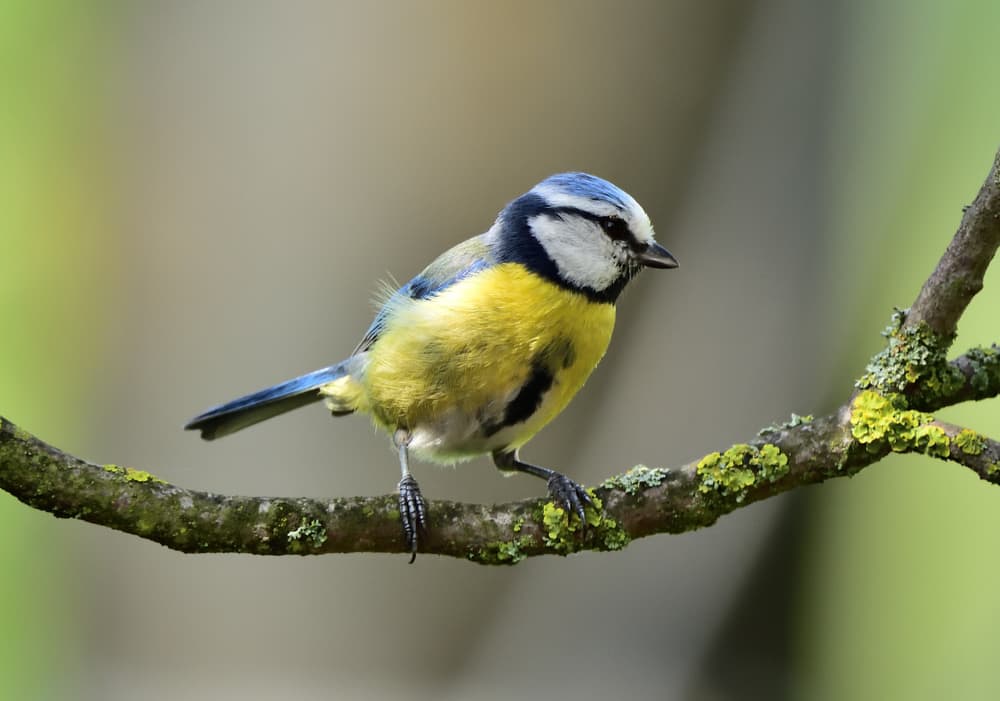
Robins
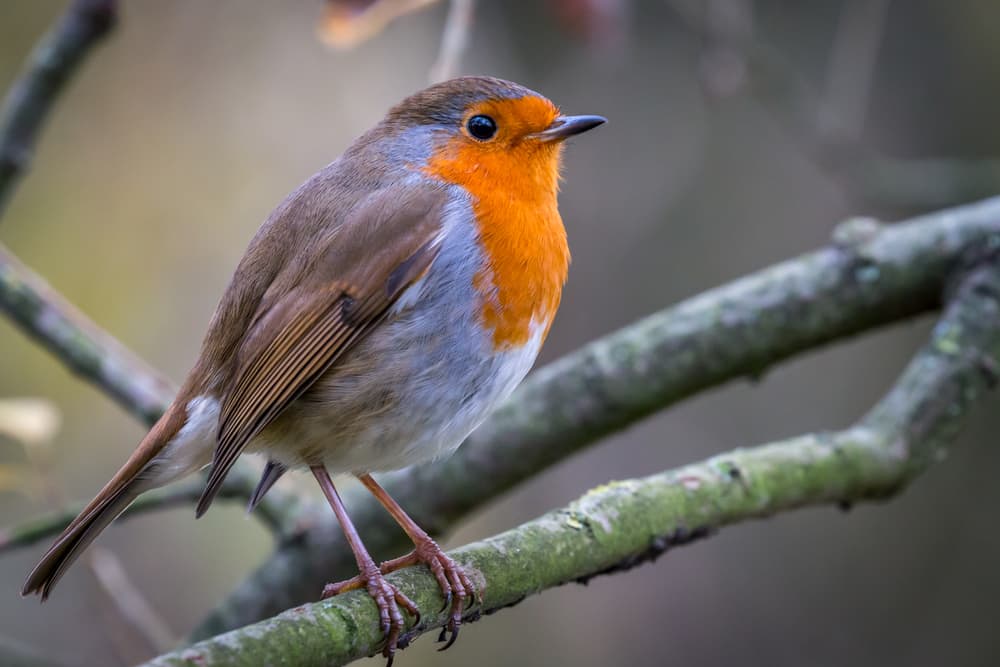
Greenfinches

Collared Doves

1) Utilise A Bird Feeder
Let’s be honest, most creatures are motivated mainly by food – thankfully, birds aren’t much different.
Setting up a bird feeder in a prime location is often a good first step in attracting birds into your garden.
When setting up a feeder, finding the sweet spot is important.

It should be close enough to a tree or bush that a bird can quickly make a getaway, but not too close that lurking cats could leap from their cover and attack before a feeding bird has a chance to react.
With this in mind, don’t be offended if birds don’t flock to your new feeder straight away: it can take them a while to get used to things, and to feel confident (and safe!) approaching something they don’t recognise.
To maximise the chance of birds visiting, keep your feeders clean.
You wouldn’t eat food from a place that others had used as a toilet, so you shouldn’t expect birds to do so.
How To Make A Bird Feeder
If after reading the previous sections you’re scratching your head, here are some ideas on how to build a bird feeder (or set up a pre-bought one).
You have almost unlimited flexibility when making a DIY bird feeder for your garden.
We’ve seen guides to make them from bowls and plates, teacups, wine bottles, jars, shoes, wooden spoons, and all sorts.

As long as there is somewhere for a bird to stand, and somewhere for food to be stored, you’ve got a functional bird feeder.
But there are a couple of things to bear in mind:
- Some bird feeder designs automatically replenish the seed from a container that animals can’t access. This can protect against one hungry animal clearing the lot, or from the wind distributing your feed all over the garden.
- An open bird feeder will attract other animals too: squirrels are notoriously fond of bird seed.
“There are all sorts of ways to make a garden more wildlife friendly, but when it comes to giving advice, I am cautious about one-hit tips such as feed the birds,” shares Gardener Naomi Slade.
“A garden may be created by a gardener, but it is still a community of organisms which relate to each other and interact together, so attracting other animals will also benefit your birds.”

2) Use Food That Birds Prefer
First, a few things not to give birds:
- Milk.
- Margarine or vegetable oil.
- Salted, dry roasted, or otherwise flavour nuts.
- Desiccated coconut: this can expand and kill birds.
- Any cheese other than mild ones.
- Cooked porridge oats: they get sticky and can seal a bird’s beak!
- Mouldy foods: while some moulds are safe, others are deadly. It’s probably best to avoid them all rather than take the chance.
Bird Seed Mix
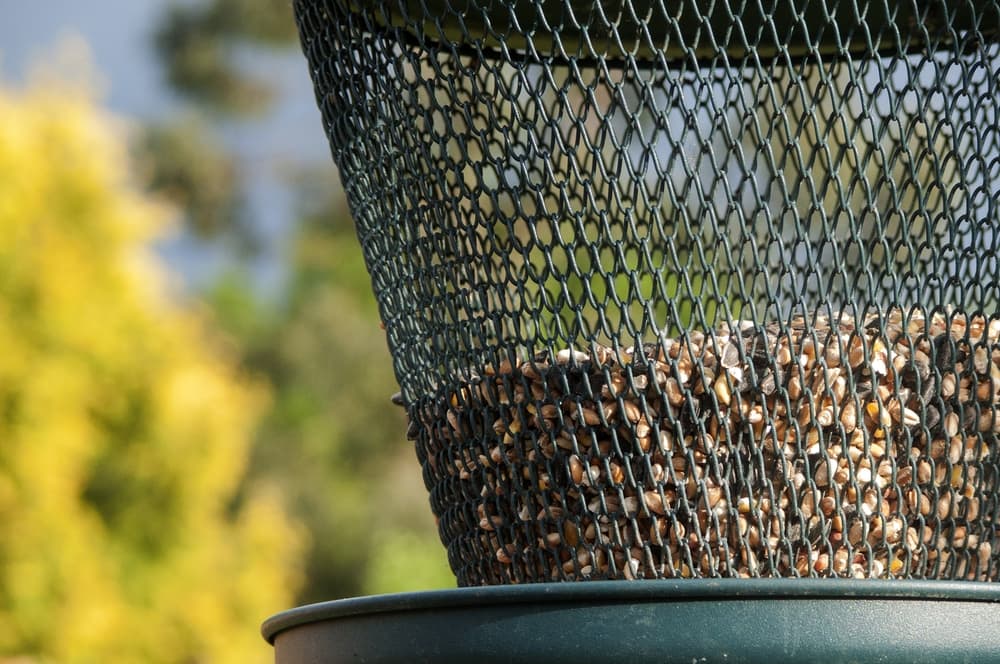
This is the first place many people look, and different mixes will contain different ingredients.
Here’s what to look out for:
- Small seeds will attract house sparrows, finches, collared doves, dunnocks, and reed buntings.
- Maize is the favourite of blackbirds.
- Sunflower seeds and peanuts will attract greenfinches, all types of tits, dunnocks, robins, and possibly wrens. Make sure they are plain and unsalted.
- Barley grains and wheat are the favourite of pigeons, doves, and the occasional pheasant.
- Nyjer seeds, which you may not have heard of, are popular with siskins, goldfinches, sparrows, nuthatches, and even woodpeckers.
And here’s what to avoid:
- Lentils and split peas are too big to be eaten dry by most bird species.
- Lumps of dog biscuits are the same: these are only suitable for birds when they’ve been soaked, which they probably won’t be in a feeder.
Not all birds will be attracted to the bird mix in your feeder. Here are some other options.
Fat Balls

We’ve all seen birds hanging jauntily upside down from a fat ball on a winter morning.
If you want to bring this unusual sight to your garden, here’s what to do.
Simply hang the fat ball from a branch after removing it from its mesh bag (if relevant) and wait for the birds to come.
You can make your own fat balls, too.

Just pour melted fat over a selection of nuts and seeds (see previous section). You want about 1:2 parts fat:mix.
Note: you shouldn’t use leftover fat from cooking, as oils from foods mix in with it and this can be problematic for birds.
Do not use margarine or vegetable oil: birds need lots of saturated fat, which these products take deliberate steps to avoid.
Live Food
Potentially not for the faint-hearted!
Buying or breeding mealworms and other types of insect can attract robins, blue tits, pied wagtails, and wrens.
Just make sure the worms are fresh, otherwise you risk making the birds unwell.
Because of the creepy crawlies involves, this option definitely isn’t for everyone.
Pet Food
Some birds love the moist chunks of dog and cat food.
The theory is that it acts as a substitute for warm wiggly worms in the depths of winter, when the topsoil is too hard for birds to penetrate.
Leaving a bowl of food out can attract blackbirds, magpies, gulls, and even cats!
If you live in an area with lots of roaming cats you may find this option counterproductive, as birds will likely be scared off by the cats you attract.
Other Foods

Grated cheese can attract robins, wrens, and dunnocks.
Cooked, unsalted rice is a great winter food and will be enjoyed by all species.
Uncooked rice will attract bigger birds and, despite myths, will not expand in their stomach and cause them to burst.
Breakfast cereal in small quantities, because large amounts quickly become soggy mush.
3) Introduce A Bird Bath
Now that dinner is taken care of, you can start to think about satisfying birds’ other needs. Namely, giving them something to drink.
All species need to drink water, and some birds also use it to clean themselves and bathe in.
Whether you decide to buy a bird bath or build your own, it’s quite a simple job.

All you need is a watertight bowl, something to raise it off the ground slightly, and some water to put in it.
When choosing the bowl, make sure it has:
- Shallow-sloping sides (more like a dustbin lid than a washing-up bowl).
- A depth of 10cm maximum.
- A width of 30cm or more.
As with bird feeders, make sure your bird bath is out of cat pouncing distance. Birds need to feel safe while bathing!
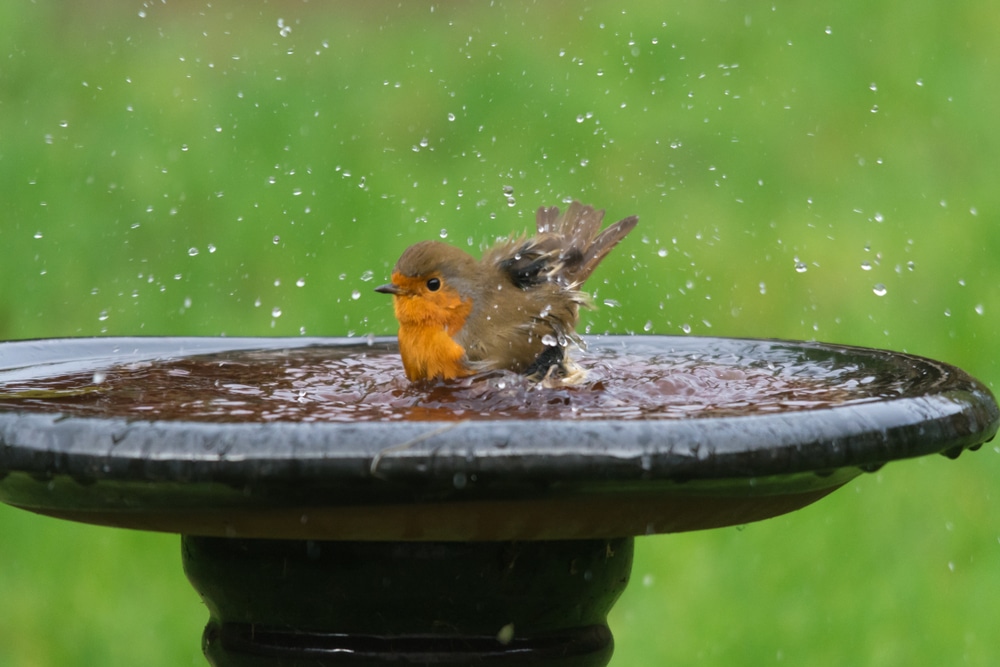
You can line the bowl with small stones to give the birds a bit more purchase.
Once your bird bath is ready you can expect to see blackbirds, starlings, robins, sparrows, wood pigeons, and more.
4) Use A Nest Box
Another option for attracting birds is to give them somewhere cosy to sleep. You may see a nest box called a bird box or nesting box.
This provision is vital for some bird species. According to the RSPB, about half of the UK’s barn owls now nest in boxes.2Providing Nest Sites For Bigger Birds. (n.d.). The RSPB. Retrieved March 17, 2023, from https://www.rspb.org.uk/birds-and-wildlife/advice/how-you-can-help-birds/nestboxes/nestboxes-for-owls-and-kestrels/providing-nest-sites-for-bigger-birds/
Again you need to decide whether to buy or build. Building one is a simple job: you just need some wood, a saw, a hammer, and a few nails.

If you decide to build, we recommend using the nest box schematics available on the RSPB website.3Where To Put A Bird Box. (n.d.). The RSPB. Retrieved March 17, 2023, from https://www.rspb.org.uk/birds-and-wildlife/advice/how-you-can-help-birds/nestboxes/nestboxes-for-small-birds/making-and-placing-a-bird-box/
A few things to consider when setting up your bird box:
- Make sure the box is deep enough, and that the entrance hole is high enough to protect small birds from falling out or being dragged out by a cat.
- Include drainage holes so that any visiting birds don’t drown.
- Sparrows will nest in colonies, so you can make a “sparrow terrace” by having a few nest boxes alongside each other.
- Face the box northeast so that it is protected from the strongest sunlight.
- A height of between two and four metres is suitable for most species.
5) Attract Birds With Plants
We’ve covered food, water, washing, and sleep so far. One more option is to lure birds into your garden with plants.
“Structural diversity and water are key to maximising insect life in the garden,” says Master Horticulturist Colin Skelly.
“This means planting as many different types of trees, shrubs and perennials as possible with as long a flowering season as possible, and making sure there is water available.
“This will ensure that the base of the food chain is as big as possible to provide the greatest food source possible throughout the year.

“This aims to provide an ecosystem in which birds can seek plentiful food and nesting opportunities with bird feeders as a bonus rather than as an essential component.”
Choosing plants with fruits and berries, or plants that attract insects, adds a few more dishes to the menu available to birds visiting your garden.
The RSPB says that thrushes in particular are attracted to gardens with berries on offer. They give this list of thrush types that you can expect to see:
- Fieldfares
- Redwings
- Mistle
- Song
You may see blackbirds, as well.
Choosing plants that are popular with insects will attract birds, too, as it brings another food source to your garden.

This can be a good workaround for people who don’t fancy buying or breeding mealworms as bird food!
Here are a few suggestions for plants that tick these boxes. For insects:
- Yarrow
- Lemon balm
- Marigolds
- Dill
- Cosmos
- Alyssum
- Fennel
- Mallow
- Lobelia
- Buddleja
- Marjoram
- Lavender
- Dandelion
And plants with berries:
- All types of currants
- Elderberries
- Holly
- Juniper
- Raspberry
These lists are far from exhaustive!
That’s It…
After reading this guide you should have a firm idea of the things you can do to attract interesting birds to your garden, whether that’s a few acres of woodland or a small urban patch.
The main things to focus on are food, drink, washing, and sleep.

Much like humans, birds will visit places where they know they can get a good meal and somewhere comfortable to hang out.
The tips in this guide have the combined advantage of making your garden a nicer space in general, too. Everyone wins!
Check out Rattan Direct’s guide to the RSPB Bird Watching Weekend for more info on attracting birds to your garden!4Cliff, D. (2020, March 17). Bird Watching Weekend with RSPB. Rattan Direct Furniture Blog. Retrieved March 17, 2023, from https://www.rattandirect.co.uk/blog/bird-watching-weekend-with-rspb/
Good luck with your newfound bird-watching opportunities.
References
- 1Bird Identifier. (n.d.). The RSPB. Retrieved March 17, 2023, from https://www.rspb.org.uk/birds-and-wildlife/wildlife-guides/identify-a-bird/
- 2Providing Nest Sites For Bigger Birds. (n.d.). The RSPB. Retrieved March 17, 2023, from https://www.rspb.org.uk/birds-and-wildlife/advice/how-you-can-help-birds/nestboxes/nestboxes-for-owls-and-kestrels/providing-nest-sites-for-bigger-birds/
- 3Where To Put A Bird Box. (n.d.). The RSPB. Retrieved March 17, 2023, from https://www.rspb.org.uk/birds-and-wildlife/advice/how-you-can-help-birds/nestboxes/nestboxes-for-small-birds/making-and-placing-a-bird-box/
- 4Cliff, D. (2020, March 17). Bird Watching Weekend with RSPB. Rattan Direct Furniture Blog. Retrieved March 17, 2023, from https://www.rattandirect.co.uk/blog/bird-watching-weekend-with-rspb/

